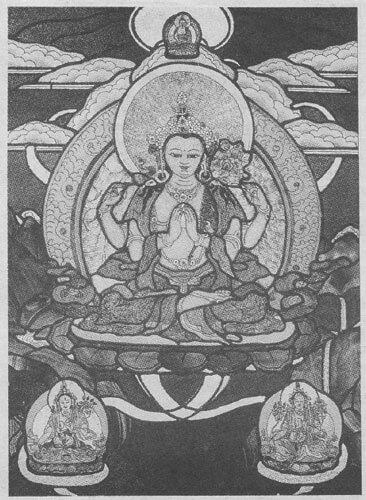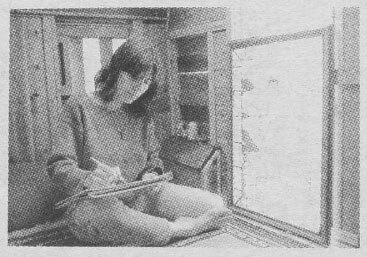| The following article is from the Autumn, 1995 issue of the Snow Lion Newsletter and is for historical reference only. You can see this in context of the original newsletter here. |
An intervieni with Jeanne Kristel
by Janet Greene, M.D.
SINCE 1970, Jeanne Kristel has been studying and practicing Tibetan Buddhism. She has been painting thangkas and mandalas for more than two decades and was encouraged by her stained glass teacher to transfer tliis tremendous talent into stained glass.
To date, Kristel's work has been lauded internationally and the depth and beauty of her work is recognized by even the most accomplished thangka painters. She leads a monastic life in Santa Fe, New Mexico, and devotes most of her time to her work, spiritual practice, and gardens.
February 23, 1995
Q: These stained glass thangkas are amazing. How would you describe what you're doing?
A: Shedding new light on an old tradition!
Q: Whatkindsofimpressionsdo you receive while working on these pieces?
A: One veiy strong impression I get at times is finding myself in an eternai chamber which I cali the Space of Glass Thangkas. While in this space, I've had the uncanny vision-like experience of being both myself who always waits there and simultaneously, myself who had just arrived. It was like catching up with myself.
Q: It sounds as though this is more than an ordinary art endeavor.
A: Well, right from the beginning I started having experiences that were of a different caliber than I'd had in ali the years I'd painted, done beadwork, etc. Seemingly out of nowhere, I'd find myself psychically looking down a dark self-luminous tunnel into the future possibilities of this particular voyage. In this mode of awareness, I receive visions, knowledge, and intuitions about potentials. It's been generating in me not only a lot of excitement, but also a greater sense of caring and carefulness.
Q: What do you mean?
A: It's a two-way street. I feel responsibility toward the beings that will see and use these thangkas for their practice. They've got to be good! And I also feel responsible to the sacredness of what these images represent. It's like wielding a power ... the last thing I want is for ego to get in there and start making decisions and pulling strings.
Q: How do you know how to paint a particular image?
A: I rely on sensing a great deal. I'm sensing responses as I paint it and I see what kind of higher emotions come into play when I get a good tete-a-tete going with the image. If it doesn't hit the mark, I start over.
When I painted the face ofTsong Kapa on my first thangka, I was struck with the responsibility that one takes on when portraying sacred personages and deities. I felt scared, actually. My teacher laughed and pointed out something which did a lot to ease my mind. If you compare a number of thangkas of one particular subject, say Padmasambhava, you'll notice a wide variance in the portrayals. This can be influenced by not only the artist's abilities and perceptions, but also the particular artistic school, monastery or region he comes from. It really Comes back to maintaining a high integrity and sensitivity.
Q: From your point of view, what makes thangkas in glass so special?

A: Well, first of ali, I want to say that I have a great admiration for traditional thangka painters. They were (and are) able to capture the self-luminous quality of the inner visionary experience with pigments on an opaque surface. Under the right conditions the painting comes to life and the space opens up. There can be no doubt that a good thangka is made with a high degree of intention and skill. But, what really excites me about the glass thangkas is that they are luminous by their very nature. Everyone who views these is getting radiated with the transformational qualities of the stained glass. Think of the cleansing radiations of colored light mentioned repeatedly in the Book of the Dead. And then when you put the conscious intention to transit into a direct relationship with the deity that is appearing before you, with an open posture toward ali the elements of the artifact itself, both you and the image come into the fully awakened present.
Q: What kinds ofreactions have you observed in people when they see your work?
A: I've seen naturally reticent types exclaim such things as magnificent! and incredible! Some people get very quiet and sparkly. I've seen rotten moods crack and fall off on the spot and the look of deep recognition in lamas who understand what these are ali about. There's also something that happens to the space at large. Aside from the obvious qualities that bringing a sacred image into a room will produce, there's something that 1 cali glass magic. Any well-made, color balanced window will definitely transform a space. There again, it's in the nature of stained glass. So no matter what kind of mechanical gabbing or level of unconscious activity is going on at the time, when the thang-kas are brought into a space, a hush falls and people naturally become more aware and respectful.
Q: Are there things you do when beginning a thangka that go beyond the technical preparations?
A: Before I start a piece, I gain knowledge and understanding of the space, energy, and presence of the deity and then infuse that into the thangka as I'm working on it. Obviously, this takes voyaging skills because I don't have years to specialize on each invocation. But I do believe that a higher necessity helps me to produce these working aitifacts and carries me a long way in this regard.
Q: How do you decide which deities to poitray?
A: At first I mostly asked my teacher for suggestions. More recently I have been doing ali conimissioned work. 1 enjoy this because it presents me with challenges both aitistically and also in getting beyond my naturai inelinations toward certain forms and figures by getting involved with what others ehoose. It broadens my perspective and level of appreciation. I also do pieces out of a sense of devotion that aiises out of my own spiritual practice.
Q: How did you become interested in Tibetan Buddhism?
A: There again, the first time I heard the word Tibet, bells literally went off inside my head. I read The Tibetan Book of the Dead, which both drew me in and confounded me. Although I have never made the cultural scene in this country of following the crowd from one ceremony to the next function, I have been with some-one for the last fifteen years who is truly the embodiment of an achaiya teacher. Extremely nonformula and at this time absolutely non-public.
Q: Apparently, you've succeeded in blending your artistic work with your spiritual work. Who were, or are, the biggest influences on you both aitistically and spiritually?
A: Aside from my glass teacher and spiritual sponsor, I should mention my father, Don Gibbins, who is an aitist to the very core of his being. I've spent thousands of hours watching his hands produce works of genius. It was paitly from him that I leamed that it's okay to include innocent humor in serious art.
There are also some very good contemporary Buddhist artists out there right now whom I admire, in particular, the painter Robert Beer. Technically, he's unbelievable, and his sense of innovativeness within a traditional artform is totally inspirational to me. His work is beyond beautiful.
Q: You mentioned that you are commissioned to do glass thangkas. Anyone we know?
A: I was commissioned to do the first Cittipatti window for E.J. Gold and just recently, I was asked to do a Kwan Yin for Dharmacrafts for the cover of their upcoming publication. Last year I was very pleased to have the opportunity to gift a special piece to the Dalai Lama. Friends have also been very supportive in getting these pieces recognized.
Q: What are your plans for the future?
A: To stay in the present.
Dr Greene was a student of H. H. Dudjom Yeshe Dorje Rinpoche and is currently engaged in bringing ethics and compassion into the medicai field.
For more information on Jeanne Kristal's stained glass thangkas, contact: Originai Light Studio, attn. Marta Jones, PO Box 22693, Santa Fe, NM 87502, 800488-3402. ?

Jeanne Kristal in her studio. Photo by Colleen Roive.

